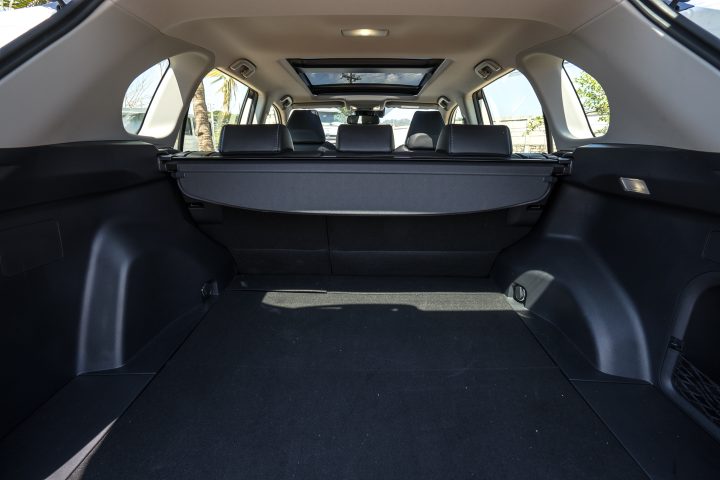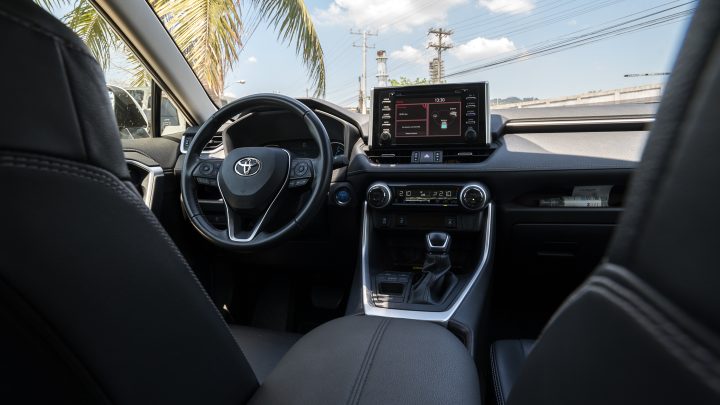
In the olden days, SUVs/Crossovers like the Toyota Rav4 were the kings of the road. It wasn’t so long ago that MPVs were a dime a dozen and those who needed space for family and for play often went for vehicles like the CR-V and the Rav4.
However, with the resurgence of MPVs and the emergence of PPVs, the Rav4 lost most of its market and has since then become a weird choice for most people. I used to agree with the majority, why would anybody pay upwards of PHP 2USD 0.03INR 3EUR 0.03CNY 0.25 Million for something that has no AWD and lacks 7 seats? Yes it was a hoot to drive and in fact, is a great car, but economically it didn’t make much sense.
Toyota wanted to address the Rav4’s lack of appeal by slapping a hybrid system on it, which now begs the question, Is a Rav4 hybrid enough to justify its existence? That’s what I wanted to find out.

Toyota Rav4 Exterior
Table of Contents
In a world where automotive companies are trying to either copy each other or one-up each other lookswise, the Rav4 is in a league of its own. It looks like nothing else out there, it has its own design identity, and a sporty one at that. I appreciate the brand’s design philosophy of giving the Rav4 an aggressively boxy and square motif.
We’re so used to describing cars nowadays as having ‘sculpted’ and molded lines, but in the case of the Rav4, it is exclusively square. It has sharp curves and edges, which as mentioned earlier lead to a sporty and macho appeal. It almost looks too aggressive and intimidating compared to its competitors.
The front fascia is the main culprit of the intimidation, the angle of the character lines, the grille, and the LED lights make the Rav4 look like it’s scowling at you all the time. While the rest of the car exterior design-wise is actually quite sedate, other main highlights include the gunmetal 18-inch alloy wheels.
Overall, despite the aggressive looks the Rav4 isn’t offputting to look at, I personally like how it has a commanding presence which older generation Rav4s didn’t have.

Interior
If the exterior was an exercise in pushing design boundaries, the interior is typical Toyota. This isn’t a bad thing in itself, at the end of the day the brand needs to appeal to the target base, which are individuals who value ergonomics and ease of use more than anything.
This led the brand to make sure that every single button is legible and within proper reach of the driver and passenger, there are no hidden buttons behind weird unseen crevices, and everything is more or less exactly where you would expect them to be.

I also appreciate how Toyota didn’t feel the need to slap on a massive infotainment screen but instead opted for a decent-sized unit surrounded by physical buttons. Call me old fashioned but an infotainment system fully dependent on a touchscreen is trouble waiting to happen. The infotainment screen has Apple Carplay and Android Auto, although not wireless let’s just be glad the features are there, moving on it also has a wireless charging pad for easier convenience although slightly negated by the wired Apple Carplay and Android Auto because once you’re plugged in, you’re charging. So in order to use the wireless charger you need to sacrifice the use of the screen mirroring features.

The instrument cluster is a mix between digital and analog, which is another good thing because it’s neat and easy to navigate once you get used to it. Also, should you find yourself smitten by your surroundings you can opt to open up the enormous panoramic sunroof. What did surprise me was the memory seating functions for the power-adjustable driver’s seat, a welcome feature for those who share driving duties with someone else.

I’m happy to report that Toyota has adorned the whole interior in soft-touch materials, and the seats (plus the steering wheel) are wrapped in very supple and fragrant leather.
My main issue with the interior will be noted later on along with my other things for improvement for the Toyota Rav4.

Engine Performance and Safety
The main draw of the new Toyota Rav4 is the Hybrid powertrain, primarily the vehicle is powered by a naturally aspirated 2.5-liter gasoline engine that makes 178 PS and 221 Nm of torque. The engine is supplemented by an electric motor that makes 120 PS for a total output of 221 PS. The transmission is a CVT unit.
Safety-wise because the Rav4 is now considered a premium car, it has the complete suite of the Toyota Safety Sense system. TSS includes Pre-Collision System (PCS), Automatic High Beam (AHB), Lane Tracing Assist (LTA), Lane Departure Alert (LDA), Dynamic Radar Cruise Control (DRCC), Blind Spot Monitor (BSM), Rear Cross Traffic Alert (RCTA).

Driving Impressions
The non-hybrid version of the current generation Toyota Rav4 was such a great car to drive, most of it I think is down to the fact that it carries the Toyota New Global Architecture (TNGA) which it shares with multiple vehicles (some of which are Lexus). Its main highlights according to the brand are agility, visibility, and stability.
The first thing I noticed while driving was how small the overall driving feel was despite the Rav4s massive proportions, not once did sweat bead down when entering small streets or parking in tight spots. Next up is the overall comfort, I kid you not when I say that this tall SUV/Crossover rides almost as well as its Camry sibling.
Dynamically speaking though is where the Rav4 shines the most, because of the TNGA platform around the corners it doesn’t feel like it’s going to tip over the body roll is so well controlled and the suspension system copes well even under spirited driving. In terms of the engine, 221 PS is no joke because the Rav4 feels light on its feet, and with the instantaneous torque of the electric motor, the Rav4 (particularly in sport mode) can shed its weight and surge forward without a hint of struggle.

Getting up to speed is so easy and the Rav4 makes mince meat of overtaking, it really is fast and that’s saying something.
Using the Toyota Safety Sense (TSS) is also quite easy, most of the settings are placed handily on the steering wheel for ease of use, and in a world where almost all brands have adaptive cruise control and lane-keep assist, TSS is in a class of its own in terms of refinement. The lane keep system is so well tuned and not aggressive, while the adaptive cruise is smooth. I was able to use the adaptive cruise and lane-keep system the whole length of NLEX without having to intervene.
Now on to the question of fuel economy, logic dictates that a 2.5-liter would be thirsty but with the hybrid system in the city during heavy traffic I got 17-18 km/l while on the highway I got up as high as 23 km/l. I drove from Manila to Subic and back without using even half a tank of fuel.

Points for improvement
I mentioned how I have one major problem with the interior of the Rav4, which is the color scheme. Hear me out, a premium vehicle like the Rav4 should have swaths of beige, brown, wood, or carbon fiber panels. It sadly has instead a predominantly black and silver interior that lacks inspiration if you ask me. There are small panels colored dark brown but they look like afterthoughts.
I also wish the brand used a more high-definition 360 camera system, most vehicles that cost (much) less have better resolution.

Conclusion
Priced at PHP 2,622,000USD 44,522INR 3,789,577EUR 42,870CNY 325,128 the Toyota Rav4 LTD Hybrid in Crystal Pearl White is not a bargain at face value. It costs more than the 7-seater top-of-the-line Toyota Fortuner 4×4 GR-S, but consider this an alternative for those who don’t need the ruggedness and the extra row, but still need the space and height of an SUV/Crossover.
Its main draw though is really the hybrid system, because we all know that Hybrids are now exempt from number coding. So technically should one buy a Rav4 they wouldn’t need another car for coding days, therefore helping decongest our streets and the environment.
That fact alone actually makes the Toyota Rav4 Hybrid a (sort of) bargain if you think about it, well would you look at that I just contradicted myself.


